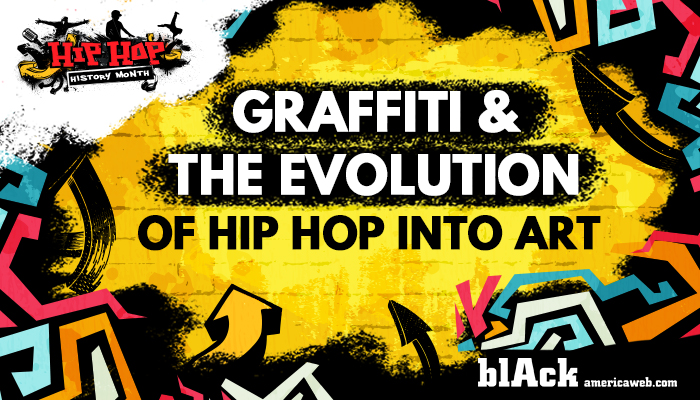Hip-Hop History Month: Graffiti & The Evolution of Hip Hop Into Art

Source: Reach Media / Radio One Digital
Art is subjective, and how we express our individual vision for it varies. One thing remains a constant though: GRAFFITI has been one of its core mediums, offering a vessel that will forever breathe new life into the streets of many cities and towns by turning blank canvases into communities of visual creativity.
RELATED: Little Known Black History Fact: Jean-Michel Basquiat
This creative expression is made up of written words used to spread a specific message, whether it be social, political or something a bit more personal from the inner elements of an aerosol spray can. Hip-Hop’s connection to graffiti dates back to the late 1960s, originating in the predominately Black and Latino neighborhoods of New York City where hip-hop music and street subcultures formulated.
In honor of Hip-Hop History Month, we will explore individuals who played an integral role in the creation of Hip Hop Graffiti, the origins of it and how it’s become a key element of Hip Hop as we know it today.
Much like we use Instagram or Twitter usernames to distinguish us as individuals, artists alike pride themselves by using ‘tags.’
Early graffiti artists were referred to as “writers” or “taggers,” defined as individuals who write simple “tags” or stylized signatures with the goal of tagging as many locations as possible with letters, numbers or even symbols.
One of the first locations of tagging was said to be in Philadelphia, Pennsylvania, while others identify the Washington Heights area of New York City as the proper birthplace.
Two artists credited with the first acts of graffiti in Philadelphia were Cornbread and Cool Earl. Both wrote their names all over the city, garnering attention from the community and local press. (Fun fact: Cornbread, also referred to as “The Godfather of Graffiti,” once tagged the side of an elephant at the Philly Zoo and also The Jackson 5’s plane at the airport.)
One first on the hip-hop graffiti writers list was said to be from New York. A Grecian named Demetrius, also known as TAKI 183, is single-handedly one of the most influential graffiti writers in its history. His tag was short for Dimitraki, a Greek alternative for his birth name, Dimitrios; the number 183 also came from his address on 183rd Street in Washington Heights, New York. When he was a teenager, he built a reputation as a folk hero by writing his name and number anywhere he wished. His graffiti is still regarded as one of the best in the world.
JULIO 204 is another founding father of graffiti writers in NYC. He started writing his nickname all over his neighborhood as early as 1968. Julio was a Puerto Rican who lived on 204th Street in the Inwood neighborhood of Manhattan, and was a member of the “Savage Skulls” gang.
Unlike street artists who need stencils and other tools to create a mural, graffiti artists choose to use spray cans when hitting up blank walls, rail ways and alleyways to create. The fundamental underlying principle of graffiti practice was the intention to “get up,” or in other words to have one’s work seen by as many people as possible in as many places as possible.
There also was a single event that changed the game of linking graffiti and Hip-Hop known as the New York City Rap Tour of 1982. Also known as The Roxy Tour, this event brought some of the most prominent rap musicians, breakers and graffiti writers together shows throughout Paris, Lyon, Belfort, Mulhouse, Strasbourg, London and Los Angeles. This was the first time Europeans had witnessed the culture as we we know it today. Hip hop had become major on a global level now, and all the elements were present all at once for an unforgettable experience.
We cannot fail to mention Fab 5 Freddy’s role in all of this either, who was responsible for combining the elements of hip-hop. Raised in Brooklyn by culturally aware Black parents, Freddy was both a participant in the subcultures and fluent in the codes and contexts of the dominant culture. This allowed him to act as a bridge between the ghetto and the media that was creating the link. Fab 5 Freddy refers to that notion of bringing together different cultures into the single concept of hip-hop as more of a personal vision.
“I developed these theories that all these elements of our urban culture were beginning to seem like one big thing. This was in 1978.”
— Fab 5 Freddy
Additionally, many of the rap music videos of that time included scenes of graffiti. The most significant of these was “Buffalo Gals” by Malcolm McLaren in 1983, which gave the world the chance to see for the first time the live creation of a graffiti piece by legendary writer Dondi.
In the late 80s, many artists were after fame and recognition and led to huge tags referred to as “bombings” getting thrown up overnight. A less complex way of tagging, you’ll see more characters with solid-colored fill and less contrasting outlines when it comes to these murals.
Today, graffiti can be seen across the world adding textures and personality to cities through powerful messages that can be conveyed so simply.
- Hip-Hop History Month: Graffiti & The Evolution of Hip Hop Into Art
- “Wild Style” The Musical? Director Charlie Ahearn Reflects 30 Years Later
- Police: Vandal with Spelling Problem Hits Pa. Car
https://www.theartstory.org/movement/street-art/https://www.theartstory.org/movement/street-art/
https://www.dictionary.com/e/street-art-vs-graffiti/
https://www.newyorker.com/magazine/1991/06/17/living-large
https://www.lofficielsingapore.com/living/5-things-to-know-about-graffiti-art
https://illegalorincredible.wordpress.com/the-history-of-graffiti/
https://www.bongminesentertainment.com/7-things-hip-hop/


